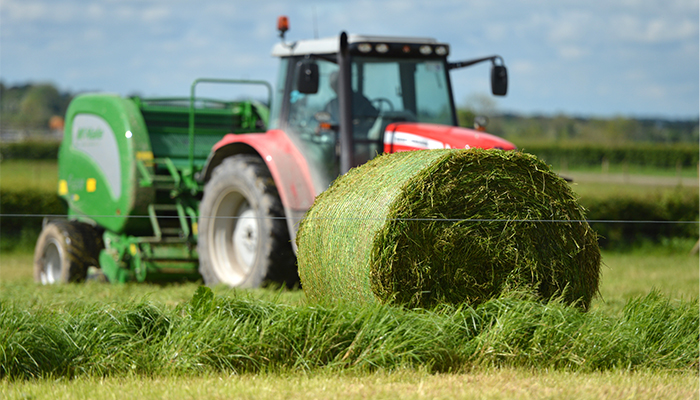Silage Quality and Concentrate Supplementation

Silage Quality and Concentrate Supplementation (PDF)
Grass silage is an important winter feed in dairy-beef systems. Balancing
this forage with the correct quantity/quality of concentrate is key to achieving the desired winter weight gains.
Why Complete a Silage Analysis?
- Visual assessment alone is not adequate to determine silage quality; laboratory
testing is recommended. - Provides information on silage nutritive value and preservation; informed
concentrate feeding decisions can be made. - A breakdown of dry matter (DM), dry matter digestibility (DMD), metabolisable
energy (ME), UFV, UFL, pH, crude protein and other relevant information will be
generated. - Mineral profiling (macro and trace) of silage can be obtained through a wet
chemistry analysis.
Correct Sampling Procedure
- Poorly taken silage samples often lead to inaccurate results.
- A period of 5-6 weeks should elapse between ensiling and sampling.
- A long core sampler should be used.
- 3-5 cores from well-spaced points on or between diagonals on the pit surface
should be sampled. - Core to within 0.5 m of the pit floor.
- Discard the top 5 inches of each core before mixing into a composite sample.
- Alternatively sample an open pit by taking nine grab samples in a ‘W’ pattern
across the pit face. - Exclude air, seal well in a bag and avoid posting samples late in the week.
- When testing bales, a number of samples from each batch of bales made must be
taken in order to get a representative sample. Test each batch separately. - Use only Forage Analysis Assurance Group (FAA) accredited labs when having silage samples analysed.
Table 1: Key Information Provided From a Silage Analysis
| Unit of Measure | Meaning | Low | High | Target |
|---|---|---|---|---|
| Dry matter (%) | Feedstuff less water content | 13-17 | 40-55 | 28-32 |
| pH | Measure of acidity | 3.4-3.7 | 4.5-5.5 | 3.8-4.5 |
| Ammonia – N (% N) | Indicator of grass N content at cutting | 4-7 | 15-25 | <10 |
| NDF (% DM) | Measure of forage fibre and intake potential | 42-47 | 55-65 | <44 |
| DMD (%) | Measure of quality | 55-65 | 76-80 | >72 |
| ME (MJ/kg DM) | Energy content (linked to DMD value) | 8-9 | 11-12 | >11 |
| UFV/UFL (unit/kg DM) | Energy content (linked to DMD value) | 0.6-0.7 | 0.89-0.96 | >0.89 |
| Crude protein (% DM) | Measures N as indicator of true protein content | 7-9 | 15+ | >13.5 |
| Ash (% DM) | Indicator of soil contamination | 5-6 | 12-15 | <8.6 |
Winter Weight Gain Requirements
Dairy-beef systems require superior quality silage, as animals have to perform at every stage of the production system. Table 2 highlights the targeted average daily gains (ADG) of animals over the winter months for various production
systems.
Table 2: Daily Winter Weight Gain Targets for Spring-Born Calf-to-Beef Animals at Various Stages
| 21 Month Steers |
23-24 Month Steers |
28-30 Month Steers |
19 Month Heifers |
U16 Month Bulls |
20 Month Bulls |
|
|---|---|---|---|---|---|---|
| 1st winter (kg/day) | 0.6 | 0.6 | 0.6 | 0.5 | 0.85 | 0.70 |
| 2nd winter (kg/day) | – | 1.0-1.05 | 0.5 | – | – | – |
Matching Silage Quality and Concentrate Feeding
- Concentrate supplementation provides energy and protein to an animal’s diet that may be lacking in silage.
- Dairy-beef systems require excellent quality silage (DMD of >72).
- Additional concentrate supplementation will be required to improve the overall energy/protein density of the diet
where silage quality is sub-optimal. - Growing and finishing animals have varying requirements for energy and protein – one concentrate will not do both.
- Ensure animals are adequately provided with minerals, either through the concentrate or additional supplementation.
- For more detailed information on balancing silage quality and concentrate feeding, contact your local Teagasc advisor.
Energy
Energy is typically the most limiting factor in beef diets. In terms of rations, weanling rations have a requirement of >0.94UFL, while >0.92UFV is necessary for finishing rations. Table 3 provides guideline daily concentrate feeding rates depending on the quality of silage (DMD) available.
Table 3: Guideline Daily Feeding Rates Based on Silage Quality (DMD)
| Animal Type | Target ADG | 66DMD | 68DMD | 70DMD | 72DMD | 74DMD | 76DMD |
|---|---|---|---|---|---|---|---|
| Weanling | 0.6kg/day | 1.8kg | 1.5kg | 1.2kg | 0.9kg | 0.6kg | 0.4kg |
| Finishing Steer | 1kg/day | 7.0kg | 6.0kg | 5.5kg | 5.0kg | 4.0kg | 4.0kg |
| Finishing Heifer | 0.9kg/day | 7.0kg* | 6.0kg | 5.5kg | 5.0kg | 4.0kg | 4.0kg |
*Ad-lib feeding should be considered
Protein
After energy, protein is the next limiting factor in the winter diet of dairy-beef animals. Always balance the protein content of the concentrate with the protein content of silage. Concentrate fed to weanlings should have a crude protein content of 14-16%, while 11-14% is needed for finishing diet concentrates.
Table 4: Crude Protein (%/kg fresh weight) Required in Concentrate Feeds for Grass-Silage Based Diets
| Animal Type | 10% CP Silage | 14% CP Silage |
|---|---|---|
| Weanlings (1.0-1.5kg/day feeding rate) | 20% | 14-16% |
| Weanlings (2.5kg/day feeding rate) | 16% | * |
| Finishing steers and heifers | 14% | 11-12% |
| Finishing bulls | 11-12% | 11-12% |
*Silage with a crude protein value of 14% or greater tends to have a high DMD value.
2.5kg/head/day concentrate feeding rates are not recommended.

